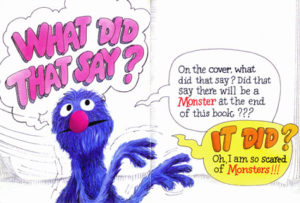Writing, Writing Advice
The Monster at the End of This Book
by
One of my favorite childhood reads was “Grover and the Monster at the End of This Book.” In the story, Grover the Muppet begs the reader not to turn the pages because he’s heard there is a monster at the end and he’s afraid. The shocking twist is that lovable old Grover is himself the monster at the end! I was thinking of this kids’ classic the other day while reading advice on how to craft a memorable villain. Your book’s monster, according to this advice, should be a reflection of the hero. But what does this mean?

Sometimes, it means that your protagonist and your antagonist share the same flaw, especially at the beginning of the story. Maybe they are both stubbornly independent and believe themselves to be uniquely gifted. The villain, however, ends up using his or her powers for evil, whereas the hero overcomes this flaw to band together with others to defeat the villain.
It also means that your villain should have roughly the same power as your hero. There’s a reason Sherlock Holmes goes up against Moriarty, a cunning antagonist who is a worthy foe for someone as brilliant as our iconic detective. It’s also the reason you so often see superheroes fighting some ‘bad’ version of themselves in comic action movies. If you’re a Hulk, then it’s not interesting to see you fight a bunch of little guys. Instead, you get to tango with a tricked-out, mean-tempered version of yourself.
This doesn’t mean that every protagonist/antagonist needs to have literal super-human powers. It just means their skillsets should be evenly matched, whether that’s an actual army or the ability to spread gossip through a small town.
A memorable antagonist should also bring out a unique side of the hero. In the Hulk example, the Hulk is both a villain-fighting hero and a kind of antagonist for Bruce Banner. He forces Banner to wrestle with relatable human problems like controlling one’s temper but also keeps Banner from living the normal existence he often craves.
Another strategy is to give your villain and your hero the same goal or dream, which puts them in natural competition. In Lolita, Humbert Humbert has two primary antagonists—Quilty, who also wants Lolita, and Lolita herself, who wants to get away from Humbert. Giving your hero and villain a shared goal can be a way to flesh out your story as the reader may be forced to question whether the villain or hero’s strategy is the best one. For example, you could argue that Danny Kaffee and Colonel Jessup in A Few Good Men have a shared goal of protecting U.S. troops, but they have very different ideas about what that protection looks like.
All of this is to say that, unlike Grover, your hero won’t find himself literally at the end of the book. But he or she should find a part of themselves, a new understanding that the villain is uniquely designed to precipitate.

